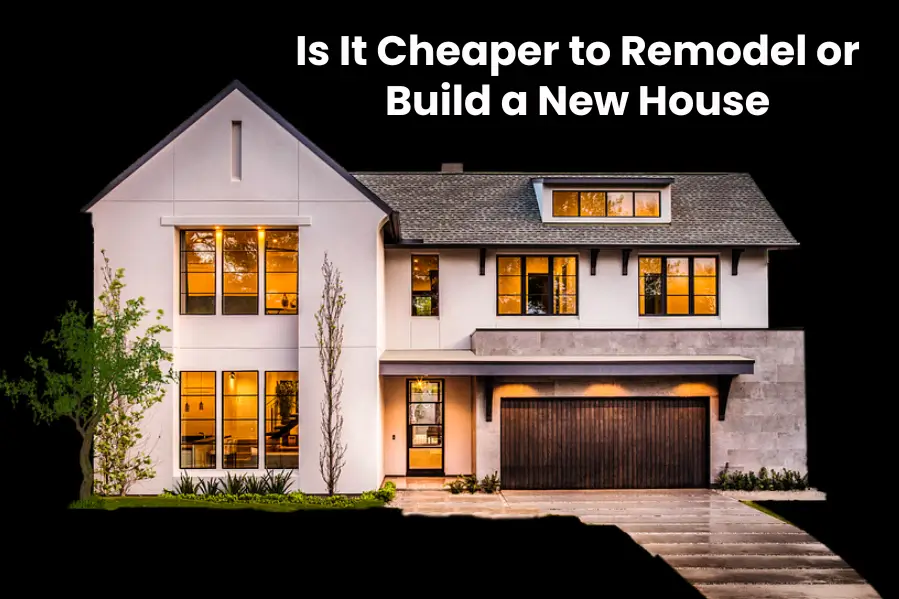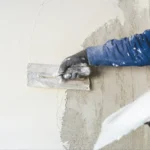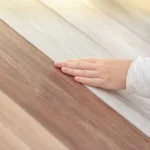Are you thinking about giving your home a makeover or starting from scratch with a brand-new build? It’s a big decision. Every little change or addition you want comes with its own set of challenges, especially when it comes to finance.
However, don’t worry; we are here to help. We will give you the proper knowledge so you can make a smart decision that fits your budget and your living standard.
In this article, we’ll examine the elements that influence the costs of renovating or building a brand-new house and much more. So, let’s get started.
Assessing Your Needs
Before you get into the financial aspect, evaluating your home’s requirements and objectives is essential. Take into consideration factors like
- The size of your family
- Preferences for lifestyle
- Long-term goals
- Knowing your needs will assist you in determining the feature that best fits accurately to your needs
Remodel a House vs Build a New One – A Complete Comparison

Deciding whether to remodel an existing house or build a new one is significant. Both options have unique advantages and disadvantages, which should be carefully considered to make the best choice for your circumstances.
1. Cost
Remodeling typically costs less upfront than building a new house. The average cost of remodeling can range from $100 to $200 per square foot, depending on the extent of the renovations. It may be easier to secure financing for remodeling, as many lenders offer home equity loans or lines of credit.
Building a new house usually has higher initial costs, ranging from $150 to $400 per square foot. Also, new construction can result in fewer unexpected costs, as everything is built from scratch. However, the great thing is that new houses can have a higher resale value and appeal to more buyers due to modern features and energy efficiency.
2. Time-span
Remodeling projects generally take less time to complete than building a new house. However, living in the house during renovations can be inconvenient and disruptive.
And if we talk about new buildings, it can take several months to over a year, depending on the complexity and size of the project. There is no need to live in a construction zone, as you can remain in your current home until the new house is completed.
3. Customization and Design
Remodeling is often limited by the existing structure, constraining design possibilities. However, remodeling allows you to preserve an older home’s historic or sentimental value. Building new offers the opportunity to design a house tailored to your specifications and needs. You can incorporate the latest design trends and technologies from the start.
4. Environmental Impact
If we consider these two options from an environmental perspective, remodeling is more environmentally friendly as it involves reusing existing materials and structures. While older homes may be less energy-efficient, renovations can include upgrades to improve energy performance.
New homes can be built with the latest energy-efficient materials and systems, reducing long-term energy consumption. However, building new material can generate more construction waste than remodeling.
Cost Breakdown: Remodeling vs Building a New Home

When comparing the costs of remodeling versus building a new home, various factors must be considered to make an informed decision.
Remodeling Costs
1. Design and Planning
Design and planning are crucial initial stages of any remodeling project.
- Architect/Designer Fees: $2,000 – $8,000
- Permits and Inspections: $500 – $2,000
2. Demolition
Demolition is a critical phase in remodeling projects. It involves removing existing structures, fixtures, and materials to make way for renovations.
- Interior Demolition: $2,000 – $10,000 (depending on the extent of demolition)
- Exterior Demolition: $3,000 – $15,000
3. Structural Changes
Structural changes are a significant component of many remodeling projects. It involves alterations to a home’s layout, support systems, or load-bearing elements.
- Foundation Repairs: $2,000 – $7,000
- Framing: $1,500 – $5,000
- Roofing: $5,000 – $15,000
4. Systems Upgrades
System upgrades encompass enhancements to the electrical, plumbing, ventilation, and air conditioning (HVAC) systems, as well as other essential home systems.
- Electrical: $2,000 – $10,000
- Plumbing: $2,000 – $8,000
- HVAC: $4,000 – $12,000
5. Interior Finishes
Interior finishes encompass a wide range of elements that contribute to the aesthetic appeal and functionality of a home’s interior spaces.
- Drywall and Insulation: $1,000 – $5,000
- Flooring: $3,000 – $10,000
- Painting: $1,000 – $5,000
- Cabinets and Countertops: $5,000 – $20,000
- Appliances: $2,000 – $10,000
6. Exterior Finishes
Exterior finishes play a crucial role in enhancing the curb appeal, durability, and weather resistance of a home.
- Siding: $5,000 – $15,000
- Windows and Doors: $3,000 – $12,000
- Landscaping: $1,000 – $5,000
Total Remodeling Cost: $30,500 – $139,000 (Average range for mid-scale renovations)
Building a New Home Costs
Let’s do a cost breakdown of building a new house.
1. Land Purchase and Preparation
Land purchasing varies widely based on location, with prices ranging from $10,000 to over $200,000. Factors such as proximity to urban areas and land size significantly influence the price.
Site Preparation typically costs $5,000 – $20,000 (grading, clearing, etc.) These tasks ensure a stable foundation for the new home.
2. Design and Planning
During this phase, homeowners work closely with architects, designers, and possibly engineers to create a blueprint that reflects their vision.
- Architect/Designer Fees: $5,000 – $20,000
- Permits and Inspections: $2,000 – $5,000
3. Foundation
Building a new foundation, including excavation, concrete pouring, and any required reinforcement, costs between $10,000 and $40,000. The type of foundation (slab, crawl space, or basement) affects the total cost.
4. Structural Construction
Structural construction involves building the new home’s framework and support systems according to the design plans.
- Framing: $15,000 – $50,000
- Roofing: $10,000 – $30,000
5. Systems Installation
Systems installation refers to the process of integrating various essential systems into the newly constructed home.
- Electrical: $8,000 – $20,000
- Plumbing: $10,000 – $25,000
- HVAC: $12,000 – $30,000
6. Interior Finishes
The interior finishes of a new house cost vary.
- Drywall and Insulation: $10,000 – $30,000
- Flooring: $15,000 – $40,000
- Painting: $5,000 – $15,000
- Cabinets and Countertops: $20,000 – $50,000
- Appliances: $10,000 – $25,000
7. Exterior Finishes
Exterior finishes are the final touches that give a new home a distinctive appearance while protecting it from the elements.
- Siding: $10,000 – $30,000
- Windows and Doors: $10,000 – $30,000
- Landscaping: $5,000 – $15,000
Total Building Cost: $147,000 – $625,000 (Average range for mid-scale new construction)
Is it Cheaper to Build from Scratch, Buy New, or Renovate?
Let’s find out whether building from scratch, buying new or renovating is cheaper.
| Factor | Build from Scratch | Buy New Home | Renovate Existing Home |
|---|---|---|---|
| Initial Cost | High ($150-$400 per sq ft) | Moderate to High (Market Price) | Moderate ($100-$200 per sq ft) |
| Customization | Full customization | Limited to available inventory | Limited by the existing structure |
| Time Frame | Long (several months to a year) | Short (move-in ready) | Varies (weeks to months) |
| Unexpected Expenses | Few unexpected expenses | Few unexpected expenses | Potential for hidden costs |
| Financing Options | Construction loans needed | Standard mortgage options | Home equity loans or lines of credit |
| Energy Efficiency | High (latest materials/tech) | High (modern standards) | Varies, can be improved |
| Resale Value | High potential | High potential | Dependent on renovation quality |
| Location Flexibility | Choose any location | Limited to available properties | Limited by current property |
| Environmental Impact | Higher (new materials/waste) | Moderate (new construction) | Lower (reuse existing materials) |
| Convenience | Low (requires planning/building) | High (immediate occupancy) | Moderate to low (living through renovation) |
Request a free, no-obligation quote For Your Remodeling Services
Are you looking to spruce up your home or business? Smart Remodeling LLC services offer a budget-friendly solution. With 13 years of experience and recognition like the 2024 Best of Houzz award, we’re here to transform your space with expertise and style. Whether you’re debating between remodeling or building new, our services provide a cost-effective way to achieve your goals.
Summing Up
So, to sum up, if you want to determine whether it’s cheaper to renovate or build new involves crunching the numbers on a per-square-foot basis. Renovating an existing house is more cost-effective than purchasing a used property or constructing a new one. However, it’s crucial to acknowledge that costs can fluctuate significantly depending on factors such as location and market conditions.






